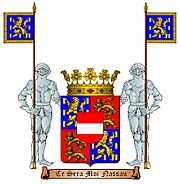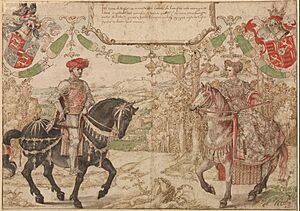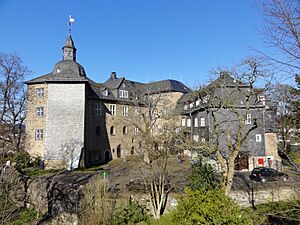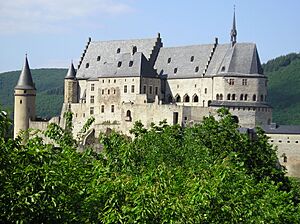John IV, Count of Nassau-Siegen facts for kids
Quick facts for kids
John IV, Count of Nassau-Siegen
|
|
|---|---|

Count John IV of Nassau-Siegen, detail of the epitaph in the Grote Kerk in Breda. Photo: Paul M.R. Maeyaert, 2011.
|
|
| Count of Nassau-Siegen Count of Vianden Count of Diez Lord of Breda |
|
| Coat of arms |  |
| Reign | 1442–1475 |
| Predecessor | Engelbert I |
| Successor |
|
| Full name |
John IV, Count of Nassau-Siegen
|
| Native name | Johann IV. Graf von Nassau-Siegen |
| Born | Johann Graf zu Nassau, Vianden und Diez, Herr zu Breda 1 August 1410 Breda Castle |
| Died | 3 February 1475 (aged 64) Dillenburg |
| Buried | Grote Kerk, Breda |
| Noble family | House of Nassau-Siegen |
| Spouse(s) | Mary of Looz-Heinsberg |
| Issue Detail |
|
| Father | Engelbert I of Nassau-Siegen |
| Mother | Joanne of Polanen |
John IV of Nassau-Siegen (born August 1, 1410 – died February 3, 1475) was an important noble in the 15th century. His full titles were Count of Nassau, Vianden, and Diez, and Lord of Breda. From 1442 until his death, he ruled over the County of Nassau-Siegen, the County of Vianden, and half of the County of Diez. He was also the Lord of Breda and the Lek in the Netherlands. John belonged to the Ottonian Line of the House of Nassau, a powerful noble family.
John inherited many lands in the Burgundian Netherlands from his father. He worked hard to make these lands even bigger. When he got married, he gained even more lands in the Duchy of Jülich, which meant he owned about a quarter of that duchy. John was a very loyal helper to the Dukes of Burgundy in the Netherlands. He even served in their army when he was in his fifties!
John was known as a rich nobleman who always fought bravely when he was called upon. He wasn't famous for big, new ideas, but he was very dependable. The battles he joined usually showed what the Dukes of Burgundy wanted, rather than his own personal goals. For managing his lands, especially in Nassau-Siegen, John had local officials called Schultheiß in different areas. One important way the Counts of Nassau-Siegen made money was from a tax on iron. Records from John's time show exactly how these taxes were collected.
Contents
Biography
John was born at Breda Castle on August 1, 1410. He was the oldest son of Count Engelbert I of Nassau-Siegen and Lady Joanne of Polanen.
Before his father passed away, John lived in a house called De Herberghe in Breda. This was after he got married.
John loved religion and science. He even had his own library at Breda Castle. This castle was his main home in the Netherlands, and he used it to manage all his lands there.
Serving the Dukes of Burgundy
John was a very loyal servant to the Dukes of Burgundy, Philip the Good and Charles the Bold. Even when he was older, he was still called to serve in their army. However, he wasn't one of their closest advisors. John was a wealthy nobleman who always fought faithfully in the wars he was asked to join. He wasn't known for doing anything super dramatic or having new ideas. The battles he took part in mostly showed the plans of the Dukes of Burgundy, not his own wishes.

Philip the Good, who became Duke of Brabant in 1430 and Count of Holland in 1433, appointed John as a drost (a high legal officer) of Brabant in 1435 or 1436. This was even before his father died. As drost, John handled legal cases that didn't go to other specific courts. It wasn't a very political job, but he had assistants and received a good yearly payment. John held this job until he died. In 1447 or 1448, he was also made drost of the Land van Heusden en Altena.
Philip the Good was interested in the Middle East. He wanted to know how to fight against the Ottoman Empire, which was a growing threat to Constantinople. So, from May 1441 to February 1442, John traveled to the island of Rhodes on Philip's orders to learn more. However, this trip didn't lead to any big plans.
There was a lot of trouble in Philip the Good's lands, especially in Holland. In 1445, Philip had to personally fix things, and John was one of the army commanders. John suggested that the city councils should have an equal number of members from two rival groups, the Hooks and Cods. This was a good idea, but it didn't completely stop all the unrest.
A bigger problem for Philip was the rebellion of the city of Ghent in Flanders. Ghent wanted to keep its independence and didn't like the Dukes of Burgundy trying to control things more. In 1452, John was part of the army that made Ghent obey. The city of Liège also wanted to be independent. Even though Liège wasn't officially part of Burgundy, Philip forced his nephew, Louis of Bourbon, to become the Prince-Bishop of Liège in 1456. In the same year, Philip's son, David of Burgundy, was made Bishop of Utrecht. John was a commander in the army that helped these new leaders take control. The people of Utrecht accepted this for a while. But in Liège, the unrest continued for many years. In 1465, there was a big fight. Again, John was in the army that put down the city's freedom. He commanded the winning army at the Battle of Montenaken. He was also there when Dinant was captured in August 1466. Even when Charles the Bold became Duke, John, despite his age, was often fighting in battles.
John's father had understood that the Dukes of Burgundy would become very powerful. John followed this idea and served the dukes loyally. He helped them take control of cities, which helped his own family's position. His son, Engelbert II, and grandson, Henry III, later became very important to the dukes and could even influence their decisions.
Count of Nassau-Siegen, Vianden, and Diez
John became Count after his father died in 1442, sharing the rule with his brother Henry II. However, Henry had already been given the County of Vianden in a marriage agreement back in 1415. In 1442, John, Henry, and their distant cousin, Count John I of Nassau-Beilstein, were given Greifenstein Castle as a fief (land given in exchange for loyalty). They also received some money from a tax in Lahnstein from Roman King Frederick III.
In May 1443, John and his brother Henry inherited the lands of their uncle, Count John II with the Helmet. On February 22, 1447, John and Henry divided their lands. John received the lands in the Netherlands, a quarter of the County of Vianden, and Herborn. They signed this agreement in Cologne.
After his brother Henry died in 1451 (Henry only had one daughter), John inherited Henry's lands. He was also given the County of Diez as a fief by Archbishop James I of Trier on November 4, 1451. This ended a long argument about that county between the archbishop and John's brother. But it started a new conflict with John's niece, Ottilie of Nassau-Siegen, who also wanted her father's part of the County of Diez as her inheritance. The problem became even more complicated because another part of the County of Diez belonged to Ottilie's father-in-law, Count Philip the Elder of Katzenelnbogen.
John joined the Soest Feud on the side of Archbishop Thierry II of Cologne. He fought alongside Count John I of Nassau-Beilstein and his son Philip. Philip died in that feud in 1446. As a thank you, John received the title of Marshal of Westphalia from the archbishop. But in 1455, he traded this title for rights to collect taxes on the Rhine River. These Rhine taxes were always important for the Counts of Nassau, because they helped with the iron trade and moving important goods to the Netherlands.
The Counts of Nassau owned a house in Cologne, which was about halfway between their lands in the Netherlands and their counties in Germany. This made it easier for them to travel between the two areas. John's many lands meant he had to travel constantly to manage them well. When he was in his German counties, he ruled from Siegen or Dillenburg. The growing number of citizens in Siegen bothered John, but he couldn't get any special rights there. Siegen's city rights had been given by John's ancestor, Count Henry I of Nassau-Siegen, back in 1303.
The County of Nassau-Siegen was divided into areas called Ämter. In each Amt, the count appointed an Amtmann. These were local nobles who acted on behalf of the count. They had servants to keep order. During wartime, they formed the main part of the army. Because John was often away for long periods, these Amtmänner had a lot of power. One of them was Philipp von Bicken, appointed by John. However, von Bicken used this trust and his own power to take too much authority. He acted like a ruler himself, trying to make his family's lands even bigger. John became unhappy with von Bicken in 1466, and von Bicken fled the county, seeking protection from Hesse. It wasn't until 1486 that John's son, John V, was able to fully control the von Bicken family.
When the count's family started staying in the county more often, a court was set up. The money management was simple; there was no difference between the count's public and private money. All income went into the count's personal funds. The count received payments from farms in villages as goods, which were given by the serfs (people tied to the land). As more coins were used, and payments in goods were replaced by money, the job of Rentmeister (a financial officer) became more important.
The count's regular income included taxes called Mai und Herbst Bede, which were collected from land. There was also the Leibbede, a personal tax paid when a serf died, usually by their relatives. This was originally the best piece of livestock, but later became a sum of money. Finally, there was a hearth tax, paid during Lent.
The count's irregular income included special taxes called Schatzungen, collected for emergencies. He also got money from tolls, which were often rented out to others. This was also true for fishing rights. Taxes were also collected in cities, on houses, gardens, fields, and meadows. The iron toll was a very important source of income for the Counts of Nassau. A document from April 1, 1470, lists the specific taxes for pig iron, steel, cast iron pans, metal sheets, and other iron goods in Siegen, Netphen, and Wilnsdorf.
Expenses included the count's travels, court celebrations, payments for officials, clothes, and church supplies. But a big part of the expenses was for workers and materials for building at the various castles. John had Dillenburg Castle expanded between 1453 and 1467, turning it into a home for his family. In 1472, he also started expanding Tringenstein Castle, which continued until 1481.
On May 28, 1470, Emperor Frederick III allowed John to buy rights to collect tolls in Königsdorf and other nearby places. The late Archbishop Thierry II had given these rights to John as payment for losses caused by the Archbishop. The Emperor saw documents that showed John had these rights and could use them for himself and his future family.
John was one of the princes ordered by the Emperor on June 12, 1470, to fight against Count Palatine Frederick I. John had the Emperor's trust. This is shown by the fact that in 1472, the Emperor asked John to question witnesses for a lawsuit between the citizens of Nauborn and the city of Wetzlar. On June 30, 1474, the Emperor told the leaders of Cologne that he would pay back some of his debt by having John pay them 600 Rhenish guilders.
John also had a good relationship with the church. He received a special letter from Pope Sixtus IV (dated February 25, 1472). This letter allowed people in his cities and castles to eat butter and milk products during Lent instead of oil. This was because they lived in a cold area where olive oil didn't grow and there wasn't much fish.
Expanding Lands in the Netherlands

After his father died, John owned several important areas in the Netherlands. These included Breda, Geertruidenberg, Klundert, Oosterhout, and Dongen. He also owned houses in Brussels and Mechelen, and lands like the Lek, Monster, Polanen, Zundert, Nispen, and Drimmelen.
On February 27, 1458, John bought more lands: Gageldonk and Hambroeck. In the same year, he gained full ownership of Steenbergen. He also made Breda free from its old ties to the Margraviate of Antwerp, placing it directly under the Duchy of Brabant. He also gave more freedoms to the city of Breda.
When John married Lady Mary of Looz-Heinsberg, he gained even more lands, including Herstal, Vught, Gangelt, Waldfeucht, and the {{Interlanguage link|Millen (Selfkant)|de|3=Millen (Selfkant)|lt=Land of Millen]]. This meant he owned about a quarter of the Duchy of Jülich. This led to an argument with his distant relative, Count John II of Nassau-Saarbrücken, whose wife was Mary's sister and also claimed some of these lands.
On May 28, 1470, Emperor Frederick III stated that giving the Duchy of Jülich to Duke Gerhard VII should not affect the claims of Mary and her sister. But this didn't seem to work, because in 1471 or 1472, the Emperor asked Duke Charles the Bold of Burgundy to settle the dispute between Gerhard and John and Mary. The argument became more complex when Gerhard VII's son, William, married Count John II's daughter, who had inherited her mother's lands. In 1474, the Emperor gave the job of settling the dispute to Archbishop John II of Trier instead.
The argument was finally settled much later, on August 25, 1499. John's oldest son, Engelbert II, gave his half of the castle and land of Millen to Duke William of Jülich and Berg. In return, Engelbert received the city and land of Diest and the castle and land of Zichem and Zeelhem on August 27, 1499.
Dispute with his Sister
John had a disagreement with his sister, Mary. She complained to Emperor Frederick III that John had taken her inheritance and goods by force. On October 14, 1463, the Emperor appointed Abbot Reinhard of Fulda to handle the case. The abbot was told to call both John and Mary to a trial, question them, and make a decision. The abbot could even threaten witnesses to make them speak.
The abbot sent a letter on August 17, 1464, telling John to appear in Salmünster 45 days later. John received this letter on September 2, 1464, in Vianden.
We don't know what the abbot's final decision was. However, on July 7, 1465, the Emperor told Mary that John had appealed against a decision made by Archbishop John II of Trier that was not in John's favor. The Emperor called Mary to appear before him. What happened next is also unclear. We do know that the Emperor called John for the inheritance dispute with his sister again, because on February 9, 1467, Mary appointed lawyers for the trial. This is the last record we have of this dispute.
Later Years, Death, and Succession
John signed an agreement with his sons on May 4, 1472. They decided how to divide his lands after his death. His oldest son, Engelbert, would receive the lands in the Netherlands. His youngest son, John, would get the lands to the right of the River Rhine (Nassau-Siegen and Diez).
John died in Dillenburg on February 3, 1475. He was buried under an epitaph (a special tombstone) in the Grote Kerk in Breda. His heart was buried in the church in Feldbach and later moved to the Evangelische Stadtkirche in Dillenburg around 1495. There, you can still see an epitaph made in 1479 with an inscription about his heart. His sons, Engelbert II and John V, took over his lands as planned in the 1472 agreement.
Marriage and Issue
John married Lady Mary of Looz-Heinsberg (born 1424 – died April 20, 1502, in Siegen) on February 7, 1440. Mary was the oldest daughter of Lord John II of Looz-Heinsberg and Countess Anne of Solms.
John and Mary had the following children:
- Anne (born 1440 or 1441 – died April 5 or 8, 1514, in Celle). She married:
- on October 28, 1467, to Duke Otto II the Victorious of Brunswick-Lüneburg (born 1439 – died January 1471);
- on January 24, 1474, to Count Philip the Elder of Katzenelnbogen (born 1402 – died July 28, 1479).
- Joanne (born 1444 – died May 1468). She married on October 14, 1464, to Count Philip I of Waldeck-Waldeck (born 1445 – died 1475).
- Ottilie (born around 1445 – died April 22, 1495, in Alkmaar). She was a nun in the Bethany Abbey near Mechelen until 1463, and then in the Saint Catherinadal Abbey in Breda from 1463 to 1476. She became the first prioress of Vredenburg Abbey in Bavel from 1476 to 1495.
- Adriana (born February 7, 1449, in Breda – died January 15, 1477). She married on September 12, 1468, to Count Philip I of Hanau-Münzenberg (born September 21, 1449 – died August 26, 1500).
- Count Engelbert II the Illustrious (born May 17, 1451, in Breda – died May 31, 1504, in Brussels). He took over his father's lands in the Netherlands. He married in Koblenz on December 19, 1468, to Margravine Cimburga of Baden (born May 15, 1450 – died July 5, 1501, in Breda).
- Count John V (born November 9, 1455, in Breda – died July 30, 1516, in Dillenburg or Siegen). He took over his father's lands in Nassau-Siegen and Diez. He married in Marburg on February 11, 1482, to Landgravine Elisabeth of Hesse-Marburg (born May 1466, in Marburg – died January 17, 1523, in Cologne).
Images for kids
-
Ottilie of Nassau-Siegen (c. 1445–1495). Portrait by master Sommeren, 1681. Saint Catharinadal Abbey, Oosterhout.
-
Count Engelbert II the Illustrious of Nassau-Breda (1451–1504). Portrait by the Master of Portraits of Princes, 1487. Rijksmuseum, Amsterdam.












